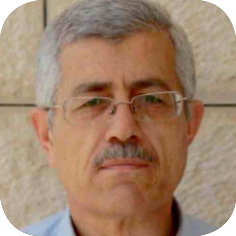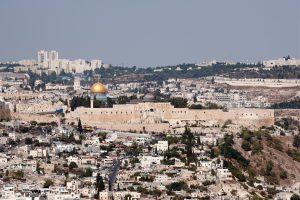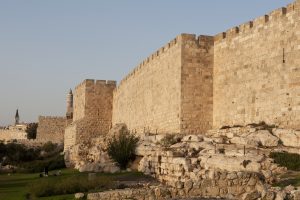The Jerusalem municipality was established by the Ottomans in 1863. At that time, it was composed of five members: three Muslims, one Christian, and one Jew. The British Mandatory Period began in 1917, and in 1918, the British appointed the members of the municipal council to include equal numbers of Muslims, Christians, and Jews. In 1929, the British decided to establish a “consultative municipal council” that included ten British officials, four Muslims, three Christians, and three Jews. This composition was later changed when council elections were conducted in 1927, leading to the election of twelve members – five of whom were Muslims, four Jews, and three Christians. In the following years, the number of Jews on the council jumped to six, representing 50 percent of its membership. In 1945, the British dissolved the council because the Palestinians rejected the system of rotation between them and the Jews for the position of mayor. After 1948, Jordanian officials held four elections for the Jerusalem municipality (Amanat al-Quds) in 1951, 1955, 1959, and 1963. The Israeli occupying authorities dissolved this council on June 21, 1967, and began to enforce Israeli law in East Jerusalem whilst extending the responsibilities of the Israeli municipality to include East Jerusalem. Nevertheless, the 1963 elected city council continued operating and still represents East Jerusalem in Arab, Islamic, and international federations of capitals and cities today. On the other hand, the elections within the Israeli municipality of Jerusalem were boycotted by Palestinian residents of East Jerusalem, which led to a drop in voter turnout. According to data published by Haaretz newspaper, municipal elections in the years 1969, 1978, and 1983 witnessed a decline in voter participation from 20 to 15 percent. Voter turnout continued to drop, with a significantly low participation of Arab voters at 2.75 percent in 1989, 7 percent in 1993, and dropping to 1 percent in the years to follow.
The Oslo restrictions did not prevent the Palestine Liberation Organization from dealing with the issue of Jerusalem and its municipality, both legally and practically. In this context, the following events took place during the terms of President Arafat and President Abbas.
During the term of President Arafat in 1998, an 11-member Jerusalem Municipality Council was appointed to include the surviving members of the elected municipality prior to 1967, as well as new members. Zaki al-Ghul, a member elected before 1967, was appointed as mayor of Jerusalem (Amin al-Quds) in order to continue to represent the municipality in Arab, Islamic, and international capitals and cities.
Arafat also issued Capital Law No. 4 of 2002, which included six articles asserting that Jerusalem is “the capital of the Palestinian state, the main and permanent headquarters of the three legislative, executive and judicial authorities”; “The Palestinian state has sovereignty over Al-Quds al-Sharif (Jerusalem) and the holy sites, and is responsible for their preservation and for ensuring freedom of worship and the exercise of religious rites.” The law also allows for the allocation of a share of the general budget for the city of Jerusalem, and programs and plans were initiated to promote public and private investment in Jerusalem, which is considered a development zone (A) area of special priority (www.muqtafi.birzeit.edu).
In addition to the Capital Law, the Committee on the Interior, Security, and Local Government of the Legislative Council proposed the draft law of Amanat al-Quds on June 10, 2001. The Legislative Council’s website states that this project was referred to the Legislative Council Committees on June 24, 2001, to the council on January 5, 2002, then for the first reading by the council on July 21, 2003, and finally, for the second reading on May 5, 2004. It was delivered to the president on May 30, 2004, but failed to be ratified. The ten-item draft stipulated the election of the municipality and its appointment in accordance with a proposal by the Minister of Local Government and by a decision of the Council of Ministers for approval by the president (Article 6). It also stipulated that the boundaries of the municipality should be defined as the borders of June 4, 1967, and that the Council of Ministers has the power to extend the boundaries of the municipality (Article 2). Concerning the powers of the municipality, it included, inter alia, the competence of the Organizing Committee for the zoning and construction of cities and villages (Article 9). (www.pal-plc.org).
During President Mahmoud Abbas’s term, an amended Law No. 10 of 2005 was passed regarding the election of local authorities. Article 69 of the law stipulates that “members of the Municipal Council shall be selected in accordance with the Law of the Municipality of the Capital (Amanat al-Quds Law).”
In January 2012, President Mahmoud Abbas issued a second decree appointing a new municipality for Jerusalem that comprised 17 members, including the remaining members of the secretariat elected before 1967, in addition to new members. (The decree can be found at www.muqtafi@birzeit.edu.) The decree included the subordination of the municipality to the Palestine Liberation Organization, provided that the National Popular Congress carry out its executive follow-up missions.
The options to regain the Palestinian right to the city of Jerusalem and to the Palestinian municipality include first, keeping the current municipality with add-ons. Second, appointing a new municipality. Third, electing a new municipality; and fourth, selecting a new municipality. These options were verified in depth by the author of this article in a policy report published by the Jerusalem Quarterly journal (see references below).
This review of the options might lead one to recommend the course of holding new elections as a first choice. If this were not possible and if the means could not be provided, the recommendation would be to use the bottom-up selection of geographical locality councils to be followed by the formation of the municipal council from representatives of these localities councils. This would be done in order to ensure the strengthening of Jerusalem’s link to the Palestinian national, political, social, and economic structure.
This recommendation would lead to the implementation of the resolution of the Palestinian Central Council of the PLO in its session held on January 15, 2018, and repeated by the Palestinian National Council’s adoption of the same resolution in May 2018. The resolution called for “the re-composition of the Palestinian Jerusalem municipality in accordance with the best democratic and representative ways possible.”
Resources
The electronic resources mentioned in the text.
“Minutes of Workshops about Amanat al-Quds Elections,” The PLO Planning Center, 2016.
The Jordanian local elections law, 2015, www.mma.gov.jo.
The text of the Palestinian Central Council resolution (January 15, 2018), www.paltoday.ps.
Usama Halabi, “Arab Jerusalem Municipality,” PASSIA, 2nd edition (in Arabic), 2000.
Walid Salem, “Jerusalem and the local elections,” Al-Ayyam Newspaper, August 15, 2016.
Walid Salem, “On the need for a new decree for Amanat al-Quds,” Al Ayyam newspaper, September 5, 2016.
Walid Salem, “Policy Report: The East Jerusalem Municipality,” Jerusalem Quarterly, Summer 2018, no 74., pp. 120–137.




